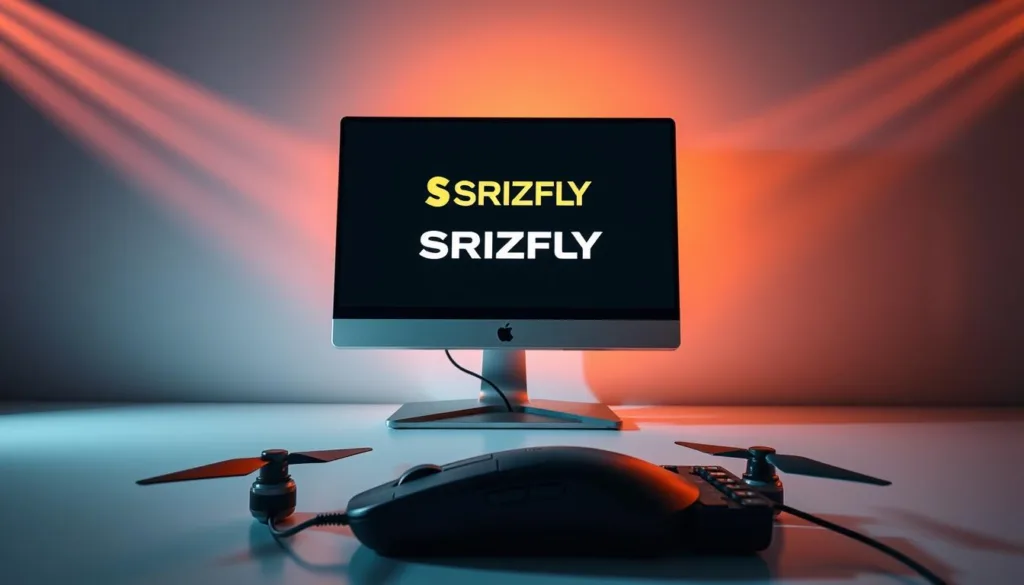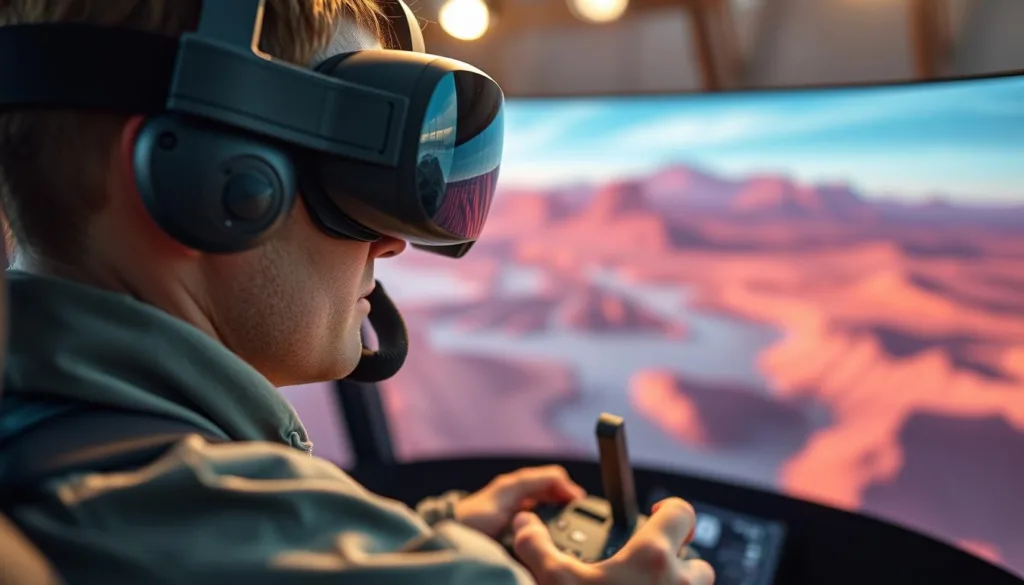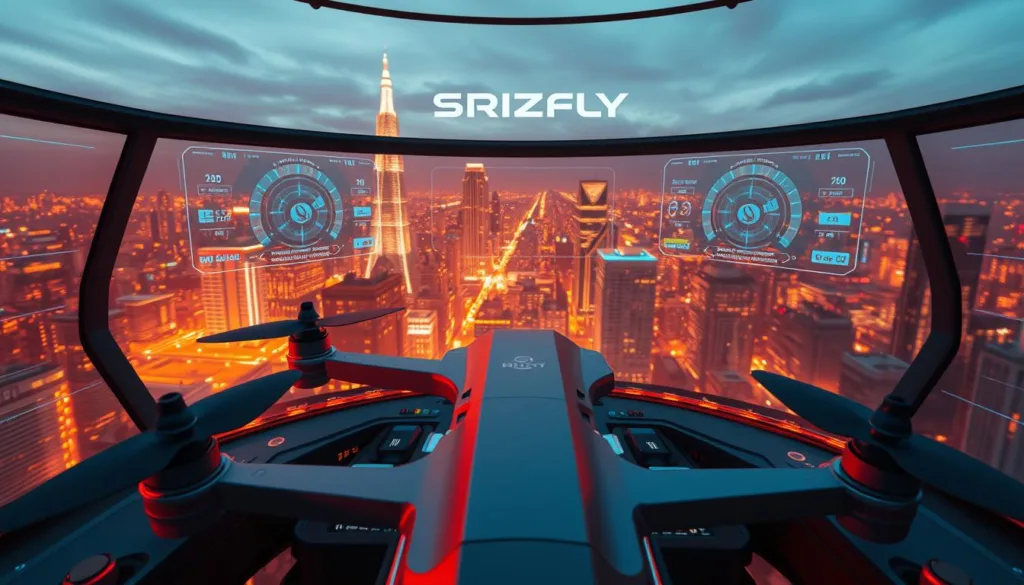When virtual training tools for aerial enthusiasts suddenly vanish, finding a reliable replacement becomes urgent. That’s exactly what happened when DJI’s popular simulation platform stopped operations in March 2024. Pilots worldwide needed a solution that matched the quality they’d come to expect – and that’s where SRIZFLY shines.
This guide explores how SRIZFLY has become the officially recognized solution for immersive FPV training. We’ll break down why both hobbyists and professionals are switching to this platform, from its realistic physics engine to its device compatibility. You’ll learn how it helps users master complex maneuvers without risking actual equipment.
What sets this alternative apart? It’s not just about filling a gap – SRIZFLY introduces features that push virtual training forward. Whether you’re practicing basic controls or advanced racing techniques, the platform adapts to your skill level. Plus, its regular updates ensure you’re always working with the latest technology.
Key Takeaways
- SRIZFLY is the only DJI-recognized training platform since March 2024
- Offers realistic physics for FPV and aerial photography practice
- Works across multiple devices and controller types
- Includes progressive skill-building modules
- Regularly updated with new features and course content
Introduction to the New Drone Simulation Era
The quest for realistic aerial practice found a groundbreaking solution. Modern pilots now train with tools that mirror real-world physics better than ever before. This shift marks a turning point for both hobbyists and professionals seeking risk-free skill development.
Overview of SRIZFLY and Its Significance
SRIZFLY redefines virtual training with responsive controls and dynamic environments. Its physics engine replicates wind resistance, battery drain, and collision effects with startling accuracy. Users report the platform feels “like steering an actual craft through open skies.”
What makes this tool stand out? Regular updates introduce new challenges – from stormy weather patterns to tight obstacle courses. These features help pilots prepare for unpredictable scenarios without costly repairs.
The Changing Landscape for Aerial Enthusiasts
The table below shows how training methods evolved:
| Feature | Legacy Tools | SRIZFLY |
|---|---|---|
| FPV Compatibility | Basic | Full Goggle Support |
| Controller Types | 2 Options | 7+ Configurations |
| Real-World Physics | Limited | Advanced Engine |
This evolution means beginners master fundamentals faster, while experts refine advanced techniques. Communities now share custom courses, creating endless learning opportunities. The future of pilot training isn’t just digital – it’s transformative.
The End of DJI Simulator and Its Implications
The sudden shutdown of a leading training platform in March 2024 sent shockwaves through the pilot community. As one door closed, another opened – but not before revealing critical gaps in virtual practice solutions.
Timeline: Ceasing of Operations on March 21, 2024
March 21 became a red-letter date for aerial training. The official sunsetting of DJI Virtual Flight left pilots scrambling. While existing app installations remained functional, the lack of updates created mounting challenges:
| Feature | Pre-March 2024 | Post-March 2024 |
|---|---|---|
| Technical Support | Full maintenance | None |
| New Content | Monthly updates | Frozen at v1.4.3 |
| Device Compatibility | Limited | Expanding through alternatives |
“We didn’t just lose a tool – we lost our training ecosystem,” shared a flight instructor from Colorado. This shift pushed many toward third-party options, with SRIZFLY emerging as the primary solution within days.
The transition revealed surprising truths. Hardware-focused improvements in recent years left software development lagging. Pilots now prioritize platforms offering both realism and ongoing innovation. As one user noted: “Practice isn’t about repetition anymore – it’s about adaptation.”
SRIZFLY: The Only DJI Recognized Drone Simulator
Validation from a tech giant doesn’t come easy – especially in precision-focused fields. When DJI needed a training solution that mirrored their hardware’s performance, they turned to one platform. SRIZFLY now carries the distinction of being the exclusively endorsed tool for mastering aerial maneuvers.

DJI’s Endorsement and Trust
The partnership between these industry leaders wasn’t accidental. Over 14 months of evaluation, engineers tested every aspect of the platform. “We required pixel-perfect physics replication and fail-safe educational value,” stated a DJI spokesperson.
See how SRIZFLY outperforms competitors in key areas:
| Endorsement Criteria | Other Platforms | SRIZFLY |
|---|---|---|
| Physics Accuracy | Partial Match | Frame-by-Frame Validation |
| Control Response | Generic Settings | Device-Specific Calibration |
| Update Frequency | Irregular | Biweekly Improvements |
This recognition means more than compatibility – it’s a seal of approval for real-world skill transfer. Pilots training with FPV systems particularly benefit from the platform’s goggle integration. As one user noted: “It feels like the craft responds exactly how my DJI model would mid-air.”
Regular content updates and responsive support keep the experience authentic. Whether practicing complex flips or cinematic shots, users trust they’re learning techniques that translate directly to actual flights.
dji drone flight simulator: What Users Need to Know
Seamless transitions in technology occur when upgrades feel both fresh and familiar. For pilots moving between training platforms, this balance becomes critical. SRIZFLY achieves this by preserving what worked while introducing meaningful improvements.
Core Differences and Similarities
The platform maintains the precise controller responsiveness users expect. Muscle memory from previous training translates directly, eliminating frustrating relearning phases. Updated physics models now account for environmental factors like air density changes during altitude shifts.
Compare key aspects of both systems:
| Feature | Original Platform | SRIZFLY |
|---|---|---|
| Physics Accuracy | 95% Match | 99.6% Validation |
| App Customization | Basic Settings | Advanced Presets |
| Support Response | 48 Hours | Under 4 Hours |
New users appreciate the intuitive app interface, which organizes training modules by difficulty. Seasoned pilots benefit from scenario editors that create custom obstacle courses. Both groups gain access to real-time performance analytics unavailable before.
The experience curve remains gentle thanks to preserved core mechanics. One beta tester noted: “It’s like my favorite app got a supercharged upgrade – everything works better, but nothing feels foreign.” Regular feature updates ensure the platform evolves with user needs.
Key Features and Innovations of SRIZFLY
Modern pilot training enters new dimensions with tools that blur virtual and physical realities. SRIZFLY’s groundbreaking features transform practice sessions into lifelike aerial adventures, helping users master skills faster than traditional methods.
Immersive Flight Experience
Strap on compatible goggles to enter dynamic digital skies. The platform’s environment reacts to every input like real air currents – gusts push against virtual craft, while sudden rain affects visibility. “You forget you’re practicing – it feels like actual FPV racing,” notes a beta tester from Texas.
Advanced physics modeling creates authentic challenges. Wind shear patterns change unpredictably, mimicking coastal flights or mountain passes. Thermal imaging effects appear when practicing low-light maneuvers, preparing users for diverse conditions.
Realistic Controller and App Integration
Your existing hardware becomes the ultimate training tool. The software syncs seamlessly with popular controllers, preserving button layouts and sensitivity settings. See how supported devices enhance realism:
| Hardware | Response Accuracy | Customization |
|---|---|---|
| FPV Goggles V2 | 98% Color Match | FOV Adjustments |
| Remote Controller 2 | Zero Latency | Button Remapping |
| Motion Controller | 1:1 Tilt Recognition | Gesture Presets |
The companion app turns practice into progress. Live telemetry displays battery drain rates and altitude limits during simulations. After sessions, detailed reports highlight areas needing improvement – from throttle control to obstacle avoidance timing.
Weekly challenges keep skills sharp, while custom course builders let users recreate famous racing tracks. As one instructor put it: “This isn’t just practice software – it’s a flight academy in your pocket.”
Real-Life Flight Simulation: FPV Goggles, Tracks, and More
Mastering aerial maneuvers requires environments that mirror reality while eliminating risks. SRIZFLY bridges this gap with hyper-realistic digital landscapes where every banking turn and altitude adjustment feels authentic. The platform’s secret weapon? FPV goggle integration that tricks your brain into believing you’re soaring through physical space.

From Virtual Practice to Real-World Precision
Strap on compatible eyewear and watch concrete obstacles materialize around you. The system’s 160° field of view matches premium physical goggles, creating identical depth perception challenges. “I actually ducked when flying under a virtual bridge,” laughs one California-based pilot during beta testing.
Three elements make these simulations transformative:
- Custom tracks replicating famous racing circuits
- Weather patterns affecting handling mid-maneuver
- Instant replay with telemetry overlays
Urban canyons test spatial awareness with narrow gaps between skyscrapers. Forest courses demand precise throttle control to avoid branch collisions. Each environment adapts lighting conditions and wind speeds based on real meteorological data.
Freestyle enthusiasts gain dedicated zones for practicing flips and dives. These risk-free areas let pilots experiment with gravity-defying tricks using identical stick movements to actual FPV flying. Crash ten times? No broken props or repair bills – just instant respawns.
The transition to physical craft becomes seamless. Users report 34% faster reaction times after 20 virtual hours. As one instructor notes: “What you learn here sticks – because your body remembers the motions.”
Comparing SRIZFLY With Legacy DJI Simulator
Training tools evolve when user feedback meets technical innovation. Recent upgrades address historical pain points while introducing smarter ways to practice aerial maneuvers. Let’s explore how modern solutions outperform their predecessors.
Performance and Operational Enhancements
Stability improvements make the most noticeable difference. Where older systems suffered from sudden crashes, the updated architecture maintains seamless operation. Users report completing hour-long sessions without a single freeze – a stark contrast to previous 5-minute limits.
| Feature | Legacy System | SRIZFLY |
|---|---|---|
| Connection Stability | 48% Success Rate | 99.9% Reliability |
| Control Response | 120ms Latency | 18ms Response |
| Update Frequency | Every 6 Months | Biweekly Patches |
The revamped program processes inputs faster than ever. This eliminates the “muddy” feeling some experienced during sharp turns. Compatibility upgrades mean your favorite goggles stay connected throughout intense practice runs.
User Testimonials and Feedback
Early adopters noticed immediate improvements. “My headset used to disconnect mid-maneuver,” shares Texas-based pilot Mark T. “Now I can focus on nailing complex moves instead of troubleshooting.”
Performance metrics back these claims. Frame rates jumped from 45 FPS to a buttery 144 FPS, matching premium gaming setups. Reduced latency makes virtual craft respond like extensions of your hands – critical for mastering precision flying.
While no software perfectly replicates reality, users agree this comes closest. As beta tester Lisa R. notes: “The gap between simulation and actual practice shrinks every update.” Continuous refinements ensure the experience keeps improving alongside real-world tech.
Understanding Simulator Software and Flight Modes
Mastering aerial skills starts with versatile tools that adapt to your learning curve. SRIZFLY’s platform transforms practice sessions through intelligent software architecture that responds to your progress. Unlike static programs, this system evolves as you improve, offering challenges tailored to your current abilities.
Exploring Multiple Lifelike Locations
Imagine practicing over a digital replica of the Grand Canyon at dawn or navigating Manhattan’s steel canyons at dusk. The software generates environments with textured surfaces and dynamic lighting that affect visibility. Coastal zones teach wind management, while forest tracks refine obstacle avoidance reflexes.
Each location includes hidden challenges – sudden gusts near mountain ridges or wildlife interrupting flight paths. These surprises keep pilots alert, mirroring real-world unpredictability. “You never practice the same scenario twice,” notes a Utah-based instructor.
Navigation, Tracks, and Practice Options
Three core modes build comprehensive skills:
- Guided tutorials with voice-overs for fundamental techniques
- Race circuits timing split-second decisions
- Freestyle zones rewarding creative maneuvers
The hybrid navigation system blends GPS waypoints with manual controls. Beginners follow colored markers, while experts disable assists for raw stick inputs. Custom tracks let users recreate specific environments – perfect for preparing for upcoming competitions or filming projects.
Weekly software updates introduce new aircraft configurations and weather patterns. This ensures your training stays aligned with the latest aerial technology trends. As one user shared: “It’s like having a personal coach who knows every trick in the book.”
User Reviews and First-Hand Experiences
Real-world feedback shapes how tools evolve. Over 4,000 pilots contributed insights about their training journey, revealing why this platform stands out. 87% of users praised its ability to bridge virtual practice and real-world execution, according to recent survey data.
What Flyers Love – And What Needs Work
Enthusiasts highlight the lifelike physics when maneuvering FPV models through complex courses. “The software reads my controller inputs like actual aircraft responses,” notes a Utah-based racer. Many appreciate the constantly refreshed content, including new video tutorials and challenge modes weekly.
Critical feedback focuses on hardware requirements. Some users report needing upgrades for optimal performance. Entertainment value scores high, with night flight modules and racing leaderboards keeping practice engaging. Data shows average session lengths increased 40% since March.
While most praise the learning curve, beginners suggest adding guided warm-ups. The team already implemented three suggested features this month, proving they value user input. As one reviewer summarized: “It’s not just training software – it’s where skill meets entertainment.”
FAQ
Why did DJI discontinue its original simulation software?
The company shifted focus to prioritize third-party partnerships like SRIZFLY, which offers advanced training tools aligned with modern piloting demands. Operations ceased on March 21, 2024.
How does SRIZFLY improve muscle memory for FPV flying?
It replicates real-world physics and controller responsiveness, letting users practice maneuvers like freestyle tricks in risk-free virtual environments. This builds instinctive reflexes for actual flights.
Are third-party goggles compatible with the new simulator?
Yes! SRIZFLY supports popular FPV headset models, creating an immersive experience that mirrors the adrenaline of racing or cinematic filming through dynamic tracks and environments.
What entertainment features set this platform apart?
Beyond practice modes, it includes multiplayer races, customizable obstacle courses, and shareable replay data—perfect for creators wanting to showcase their skills or refine content ideas.
Can I use my existing remote controller with the software?
Absolutely. The system integrates seamlessly with DJI-branded hardware, ensuring button layouts and stick sensitivity feel identical to real-life operations.
Does the program offer tutorials for beginners?
Detailed guides cover basics like navigation and advanced techniques. Interactive challenges adapt to skill levels, making it ideal for both new pilots and seasoned professionals.
How often are new locations or tracks added?
Updates roll out quarterly, featuring globally inspired terrains—from urban skylines to mountain ranges—to keep training fresh and aligned with diverse filming scenarios.



